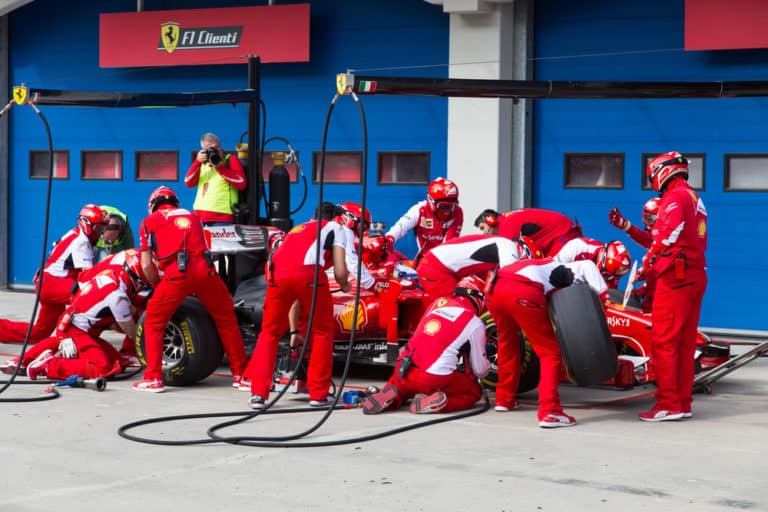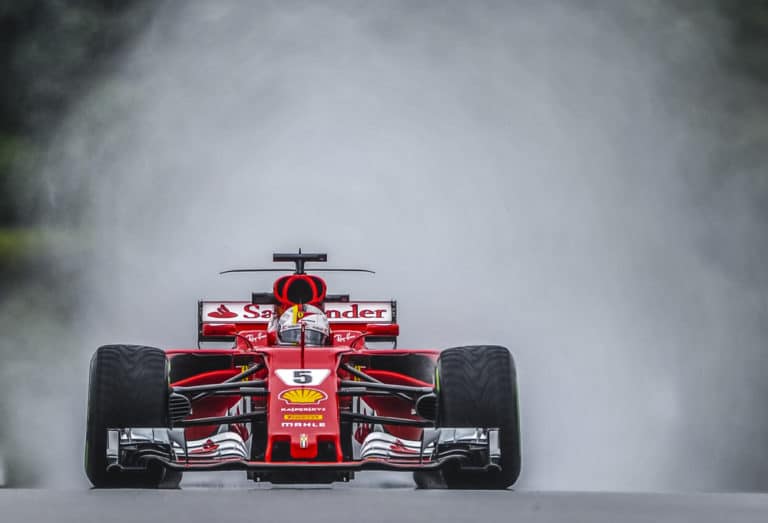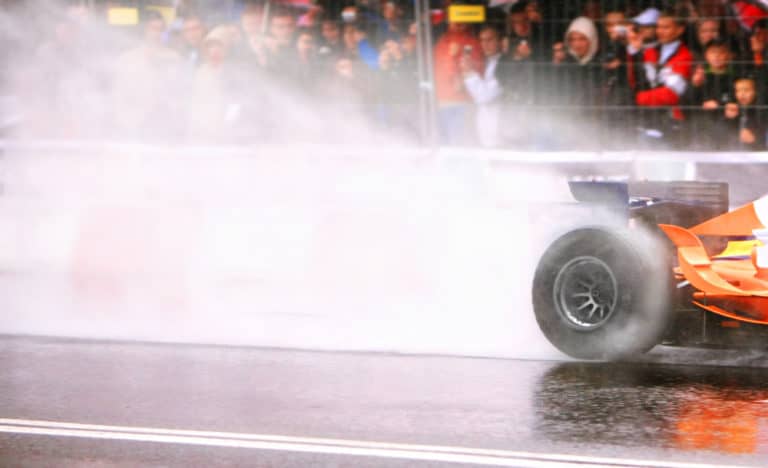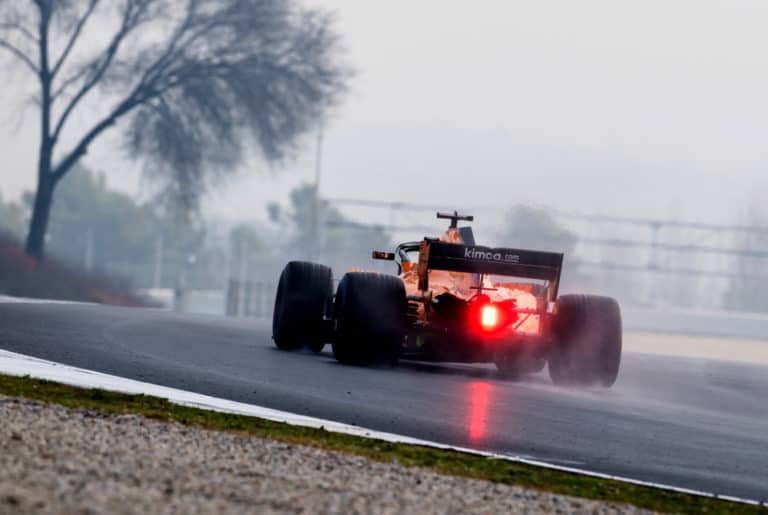Images editorial credit: Hafiz Johari / Shutterstock.com & Grindstone Media Group / Shutterstock.com
Formula 1 and NASCAR are two of the most popular motorsports in the world. Both of these racing forms are highly impressive, and there are many factors that contribute to the excitement, thrill, and dynamics of their respective races. However, while the cars that race in these sports are so different, they are both capable of almost the exact same speeds and racing prowess. This leads many to wonder, F1 cars vs. NASCAR cars, what’s the difference?
F1 and NASCAR cars are different in almost every way. Everything from their aerodynamic design and engine to the tires and the way the cars are driven are completely different from each other. Both machines are capable of incredible racing speeds, with every aspect of each car purposefully designed.
The cars that are used for F1 and NASCAR are vastly different machines, but they are both capable of incredible speed and performance. Both cars are high-performance vehicles that are specifically designed for their respective races, but how do these cars really compare? What’s the difference between F1 and NASCAR cars? Let’s find out!
What Are The Main Differences Between F1 Cars And Nascar Cars?
The vehicles that are used for F1 racing and NASCAR racing are purpose-built for winning their respective races. This means that they are built to be vastly different due to the vastly different nature of the races that they compete in.
While both cars are capable of incredibly high speeds and intense performance, almost every aspect of the two cars is completely different from each other.
There are obvious differences between the two vehicles, such as the way they look, but both cars run at very similar top speeds and performance levels. Are they really so different?
Let’s take a closer look at the real differences between F1 racing cars, and NASCAR racing cars, to better understand how they are both capable of such similar speed figures while being so obviously different from each other.
Here are the main differences between F1 and NASCAR cars:
Car Size
Let’s begin with the most obvious difference – the size of the two cars.
F1 cars are significantly smaller than NASCAR vehicles in height, width, and weight. Every F1 race car has to adhere to strict size regulations that dictate the dimensions of the vehicle.
The cars that are used for Formula 1 racing can be a maximum of 200cm (about 78.7″) wide and 95cm (about 37.4″) tall. The length of the car is not limited, but they are all generally about the same length at about 5m (16.4ft).
Formula 1 cars are built to a minimum weight that no car is allowed to be lighter than. According to the 2021 F1 race regulations, no car can be lighter than 752kg (around 1657lb), which means that most F1 cars weigh exactly 752kg.
This is a drastic contrast to the dimensions of a NASCAR vehicle. The cars that race in NASCAR are significantly larger than F1 racing cars with regards to their height, width, and weight, but surprisingly are smaller than F1 cars in length (in most cases) and width.
The cars that are used in NASCAR in 2021 are still being run according to the Gen-6 standards. The regulations for NASCAR are much looser than F1, which means that the cars do not all have to be the same dimensions.
However, the dimensions of the NASCAR vehicles are all roughly similar. The dimensions are usually at the height of around 53″ (134.5cm), width around 110″ (279.4cm) – 120″ (304.8cm) at the wheelbase, length about 190″ (482.6cm) – 200″ (508cm), and the cars usually weigh in at around 3100lb (1400kg) – 3900lb (1770kg).
These figures may seem daunting to understand, but it essentially comes down to the F1 cars being shorter, lighter, and narrower than NASCAR cars. While NASCAR cars are larger than F1 cars in every respect other than length, where they are notably shorter.
The biggest difference in the size of the two vehicles comparatively is the weight. F1 cars are 648kg (1428lb) lighter than NASCAR cars. This means that a car used for NASCAR is almost the weight of two Formula 1 cars combined.

Car Body Shape And Design
The shape and design of Formula 1 versus NASCAR cars is another obvious difference between the two vehicles.
F1 cars are designed for maximum downforce and aerodynamics, making use of diffusers, wings, fins, and aerofoils to make the cars as light and fast-moving as possible.
Formula 1 racing cars have nobody shell to speak of, and their wheels and cockpit are exposed. Sharps wings, spoilers, and fins surround the driver in an effort to help the car move through the air around them as efficiently as possible while making the best use of the air flowing around the car to increase performance.
NASCAR cars are not designed to such stringent tolerances, and their design is far more simple yet still effective for the nature of NASCAR races.
The cars that race in NASCAR are bulky and square compared to F1 racing cars, but this does not mean that these cars are not aerodynamic or designed with an intentional body shape.
These cars are built for maximum speed, so they are aerodynamically sound and designed for cutting through the air and keeping the vehicle pressed down on the track surface.
Unlike F1 cars, the NASCAR vehicles are body shells attached to a chassis, rather than just an open structural chassis with a cockpit. This means that NASCAR cars resemble regular cars, just as F1 cars resemble science-fiction space cruisers.
NASCAR cars have features that F1 cars do not, such as flaps that deploy if the vehicle turns sideways to prevent it from rolling. These innovations are a testament to the sophisticated design of NASCAR cars, even though they may not be as space-age as F1 cars.
Racing Chasis
The chassis of these two vehicles is a vital difference to consider as well.
F1 racing teams are required to develop their own unique chassis’ that adheres to the regulations enforced for F1 racing. This means that every F1 team races with cars that have unique chassis, and using the same chassis as another team are not allowed.
The chassis’ that are designed for Formula 1 cars are designed and manufactured by the Formula 1 teams themselves. This means that the teams with more sophisticated design and manufacturing technologies produce better racing chassis.
In NASCAR, the racing chassis’ are on a more even par. The chassis’ that are used by NASCAR teams are not unique nor designed by the teams, but they are rather designed and built by major motor vehicle manufacturers that are represented in the race, such as Ford and Chevrolet.
The chassis’ that are used for NASCAR vehicles are based on the next generation of road vehicles produced by the manufacturers. This concept is known as “The Car Of Tomorrow.”
What this means is that the chassis’ used for the racing cars are intended to be used by the manufacturer for their road vehicles in coming years. The NASCAR teams buy the chassis from the manufacturer, and this reduces the cost of the car and puts the vehicles on an even level.
Racing Engines
The engines that are used by the two types of racing vehicles are the most significant difference between them apart from the way they look.
The power unit that is used in Formula 1 racing is as strictly controlled as the rest of the sport. All F1 cars run 1.6L V6 hybrid turbocharged engines. These engines have between 875hp – 1000hp and produce around 600 – 650 Nm of torque.
These engines are incredibly high-tech and refined, being specifically built to produce the maximum amount of power while being as lightweight and small as possible.
In NASCAR, weight and size restrictions are not as prevalent, but the engines are all roughly the same in every car.
NASCAR vehicles run naturally aspirated 5.87L V8 engines that produce around 850hp and run at around 9500rpm while racing.
Racing Tires
The tires that are used for F1 racing cars are available to every team in seven different rubber compounds.
This means that there are seven different types of tires available for F1 cars to use. Two of which are designed for wet weather racing, and the other five are designed for dry conditions with varying levels of hardness and grip.
However, only three tire compounds are available for an individual race. This is decided by the tire manufacturer based on the race track and the racing conditions on the day of the race.
These tires are used on 18-inch rims on all F1 racers since 2021 and weigh 10kg (22lb) each, as per racing regulations.
NASCAR tires are a little less complicated, as each car has either a wet or dry tire, with the rubber compound adjusted accordingly, and each wheel is a 15-inch tire on a 9.5-inch or 10-inch rim.
That being said, there are plans to increase the size of the tires to 18-inches in the near future to coincide with the next generation of NASCAR racing cars. NASCAR tires weigh 25lb (11.4kg), making them only marginally heavier than F1 racing tires.
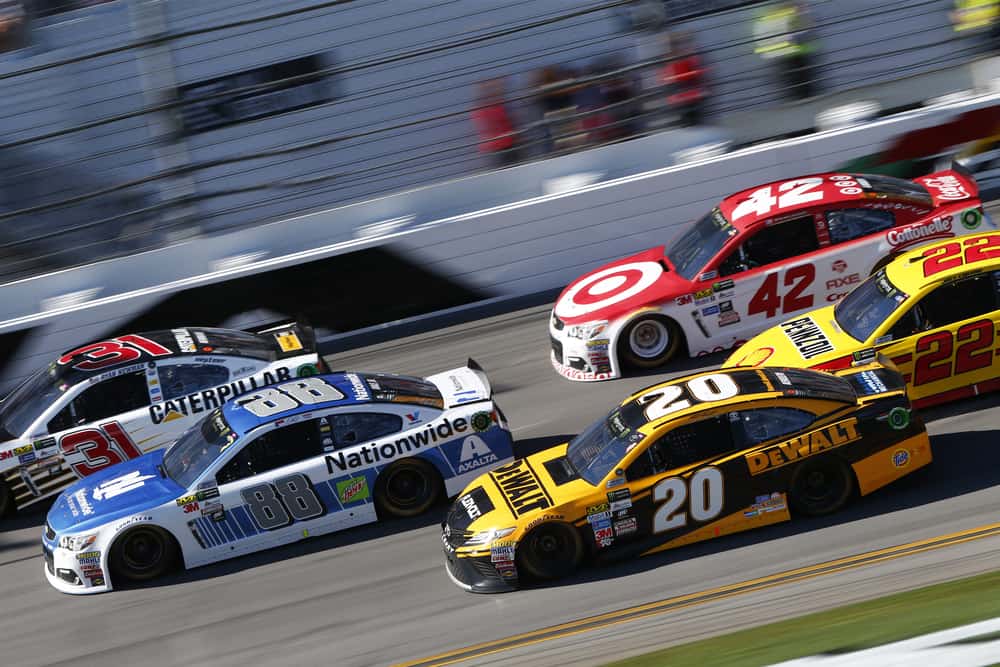
Handling
F1 cars are designed to be raced around some of the most challenging race tracks all over the world. These tracks are riddled with sharp bends, many corners, slopes, inclines, and many other features that make them very tricky to traverse.
The tracks that F1 cars are required to race on has resulted in the racing cars being very dynamic and very nimble vehicles.
Formula 1 cars are designed to be as maneuverable as possible through tight corners and bends in both directions, making use of their tires, aerodynamics, bodywork, and clever suspension to get around the winding F1 tracks as quickly as possible.
NASCAR racing cars are not nearly as agile as F1 racing cars.
These cars are only designed to turn left, around a never-ending left-turn that in the NASCAR racing track. Every NASCAR track is the same, and so the cars can be set up to race in the same way for every tack.
The cars that are used in this sport are not required to be agile in any way, but they are required to be able to handle the intense stresses of constant cornering without buckling or losing control.
The vehicles are set up to turn left. They do not like to drive straight, and they do not like to turn right, but all they need to do is hold a left turn for 500 laps, and if they can manage that without coming apart, they have done well.
Vehicle Price
Formula 1 cars are precision machines that are built with exact specifications and tolerances that are unmatched anywhere else in motorsport.
This level of engineering comes at a very steep price. Each team has a varying budget for their cars, and every team runs two cars in every race.
The exact price of an F1 car is a closely guarded secret, but there are estimates that one F1 car may cost a team $15.52 million. This is not taking into account the many millions of dollars that are taken to design, develop, and manufacture the cars.
Each team runs two cars, so the cost of the cars per team is over $31 million.
This is a drastic contrast to the comparatively minuscule amount that is spent on a NASCAR racing car.
NASCAR vehicles cost between $200 000 and $400 000 per vehicle. This includes all engines, tires, chassis, and other components that make up the vehicle.
Most of the cost of F1 cars goes into designing and manufacturing their own bespoke vehicles for every season, while NASCAR vehicles cost comparatively far less because they do not have to manufacture their own components nor adhere to such strict regulations.
Are F1 Cars Faster Than Nascar Cars?
This is a very hotly debated topic among motorsport enthusiasts, as these two types of racing, machines have very similar top speeds.
However, top speed is not the only determining factor in motorsport, as there are many other aspects of the cars’ performance to consider before concluding which the faster machine.
Let’s thoroughly compare the speed of the two cars to determine which of the two is really faster.
The top speed record in Formula 1 is 246.908mph (397.360km/h). it takes an F1 car 2.5 seconds for an F1 car to reach 62mph (100km/h), and they reach speeds of over 200mph in around 9 seconds.
Comparatively, the highest speed recorded in NASCAR is 212mph (341.181km/h), and these vehicles take 1 second longer to reach 62 mph than F1 cars do. It takes 9 seconds for a NASCAR racer to reach 160mph.
These statistics definitively prove that Formula 1 racing cars are the faster of the two racing machines.
This is not to say that NASCAR vehicles are by any means slow, only that F1 cars are quicker around a track and have faster acceleration.
Conclusion
At the end of it, comparing F1 cars and NASCAR cars is very difficult. These vehicles are both built for racing, but the type of racing that they do is so incredibly different from one another that they have been bred to vastly different racing cars.
NASCAR vehicles are large and heavy. They are designed to go around an oval track at over 200mph for hours on end.
F1 cars are low and light, and they are designed to tackle twisting tracks for short amounts of time at break-neck speeds.
The racing cars used in NASCAR run huge engines that are designed for running at high speeds for extended periods, while the F1 engines are smaller and turbo-charged with electric boost and energy converting technology that is designed to propel the car around a track sustainably for only a short while.
The needs of these two vehicles are based on the requirements of their racing conditions, and so the cars are very different. They can not be fairly compared, but there is some conclusion that can be made:
F1 cars are faster and lighter but not as durable. NASCAR racers are heavier and taller but travel at similar speeds to F1 cars for longer periods. F1 cars are quicker off the line, but NASCAR vehicles have more endurance.
While these two types of racing machines are so vastly different from one another, there is no doubt that these vehicles are both incredible racing machines that are deserving of all the accolades and praise that they get!
References
- https://www.thethings.com/major-differences-between-formula-1-and-nascar/
- https://f1chronicle.com/difference-between-formula-one-and-nascar/
- https://keepitgnarly.com/5-reasons-why-a-formula-1-car-is-faster-than-a-nascar-car
- https://www.tutorialspoint.com/formula_one/car_design_specs_rules.htm
- https://www.sportskeeda.com/f1/how-much-formula-1-car-weigh
- https://en.wikipedia.org/wiki/Formula_One_engines
- https://en.wikipedia.org/wiki/NASCAR_Cup_Series
- https://en.wikipedia.org/wiki/Formula_One_tyres
- https://www.tireamerica.com/resource/nascar-tires
- https://carfromjapan.com/article/industry-knowledge/how-much-does-a-formula-1-car-cost/

